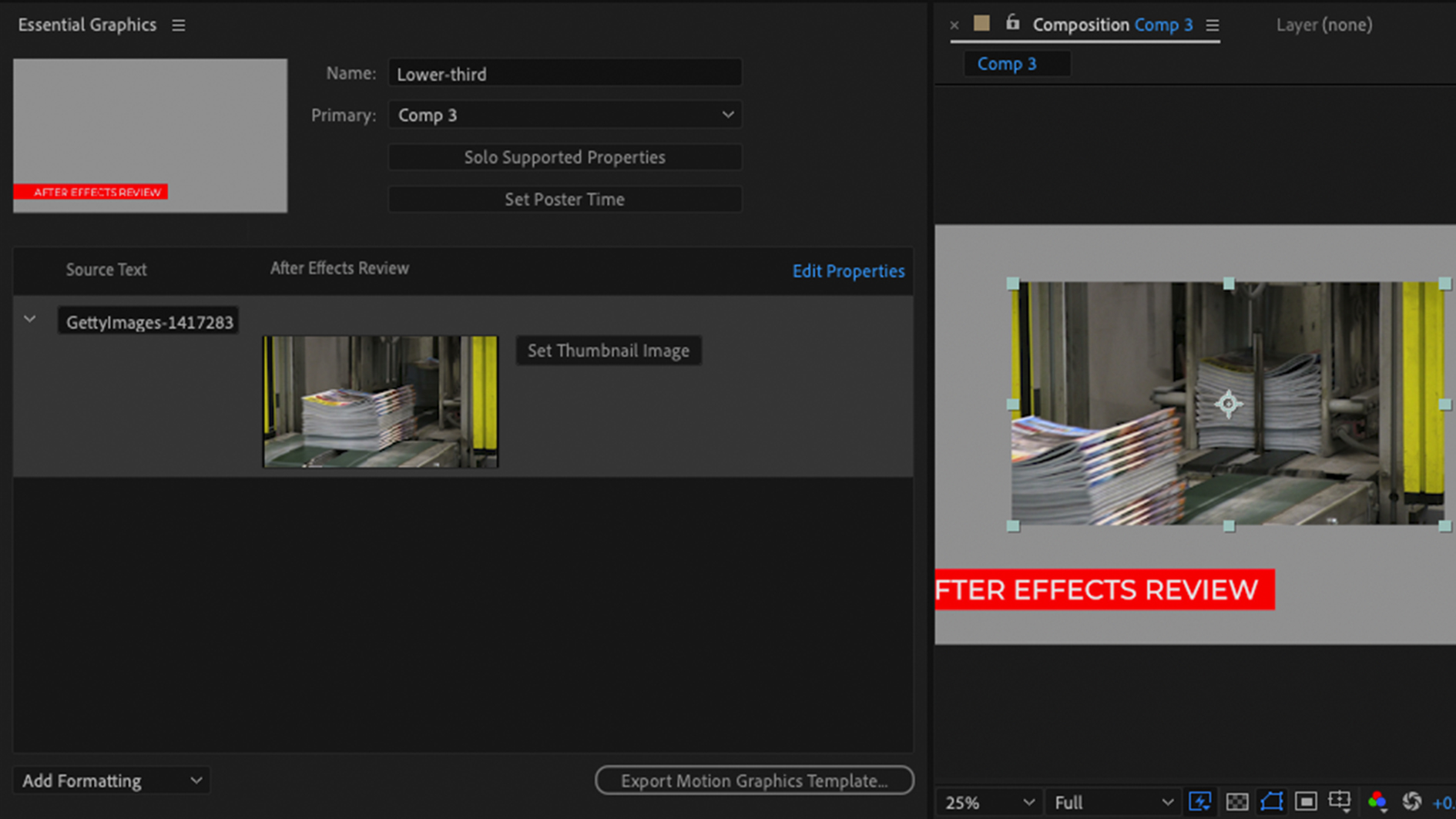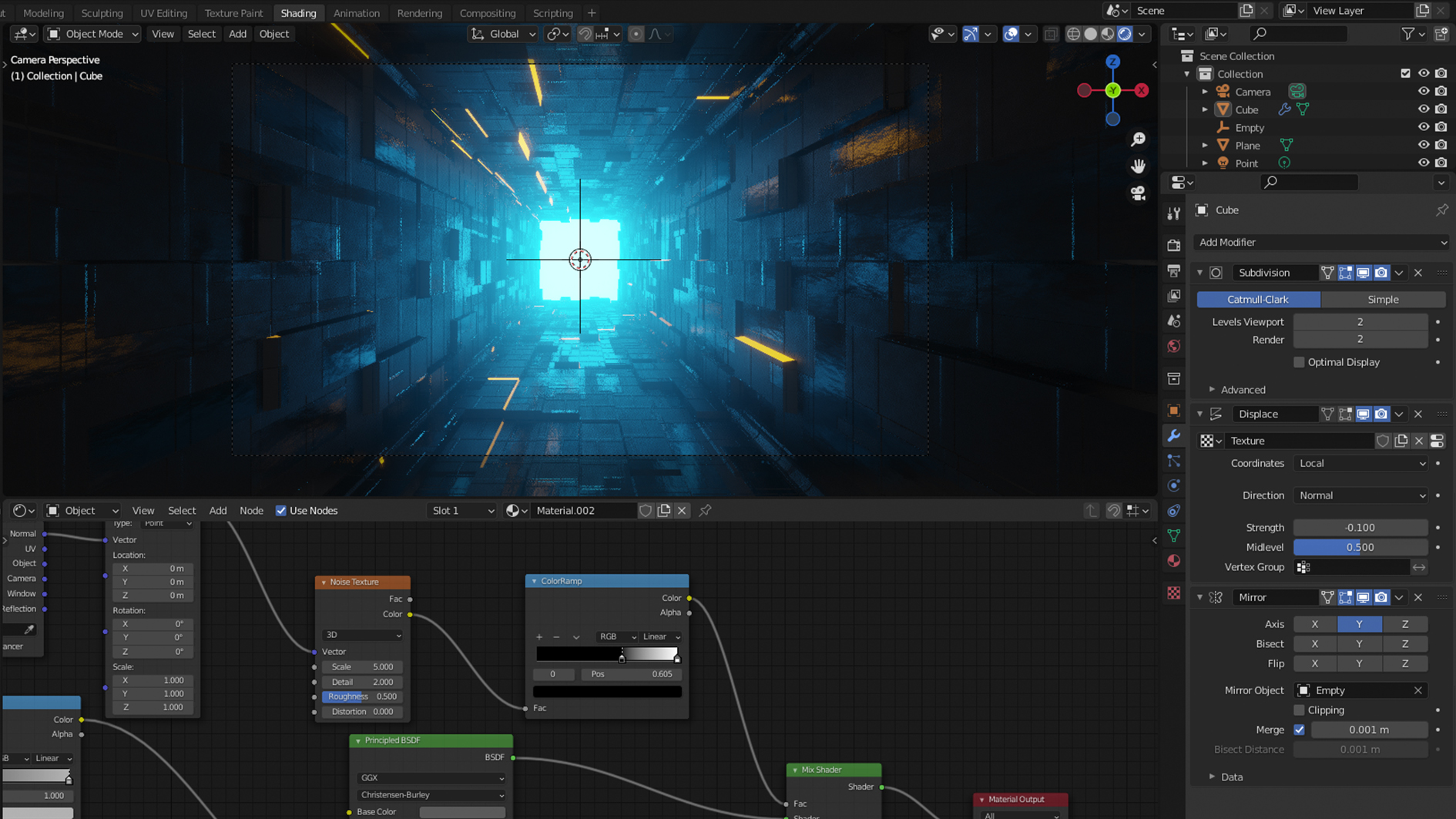Our Verdict
After Effects remains the leading light for creating modern animations and motion graphics, boasting a vast array of tools for beginners and pros alike.
For
- Extensive toolset for all abilities
- Huge community
- Intuitive interface for CC users
- Content-Aware Fill
Against
- Steep learning curve
- Rendering still slow on average computers
- Limited options in the in-app Render Queue
- 3D capability is limited
Why you can trust Creative Bloq
Anyone with an interest in video editing has probably heard of After Effects. At its simplest, After Effects is a compositing and motion graphics app for video, but over the years it has become the go to software for all kinds of visual effects – creating titles, animating text, characters, 3D and even 360 degree VR footage.
After Effects (AE) is powerful and versatile, used by beginners, hobbyists and is still the industry standard for professionals. You could spend years using it and still only have scratched the surface. The only limit is your imagination (and the power of your GPU – see our best computers for video editing page if you need an upgrade).
At $20.99 / £19.97 per month, AE may seem a little expensive, but while there are similar packages out there, nothing offers the wide range of features and benefits that come with After Effects. If you already have a CC subscription then you’re already set to go (if not, check out our Adobe CC discount page to see if you can grab a bargain)! If you're still not sure, check our buying guide on After Effects alternatives, otherwise read the full review below.
The last few years of AE updates have focused more on improved performance and creating a more efficient workflow for users, indicating that Adobe is committed to finding a better overall experience for its customers, ahead of the cheap bells and whistles that bring more immediate gratification. The 2021 version is a little light on new and exciting features, trending more towards shared team working and slightly improved 3D capabilities. But there have been some notable recent inclusions that are well worth having a look at:
Adobe After Effects: Content-Aware Fill

Anyone familiar with Photoshop should be aware of Content-Aware Fill. It isn’t the newest feature for After Effects, but probably the biggest and most game-changing inclusion over the last few years.
Removing an object from a still image is a relatively simple process in Photoshop, but when working with video it becomes far more complicated and time-consuming. Traditionally this effect was accomplished with rotoscoping – manually drawing a path around an object on each frame to remove it and clone in the background behind. This technique is still widely used in the industry and After Effects still lets you rotoscope with an improved Roto Brush. With Content-Aware Fill you can get the same effect with the click of a button. Just draw a quick mask around the object and let the software do the rest.
As with Photoshop, the results are variable and sometimes disappointing, depending on the content of the picture (see our PS review for more info), however you can improve the effect by creating a reference frame that will be used in the calculations to get a more seamless result. it’s certainly a feature to get excited about, especially with the ever evolving Adobe Sensei engine.
Daily design news, reviews, how-tos and more, as picked by the editors.
Adobe After Effects: Motion Graphics Templates

Motion Graphics Templates are a practical way to manage video graphics across a team, especially if other team members are proficient in Premiere and not After Effects. These templates allow editors to import pre-made motion graphics into Premiere Pro and make basic edits without altering the original file. In the past these were limited to basics like editing text, but this update allows the end user to replace media such as images or video. They can help maintain consistency and quality across the board, preventing any unskilled members from changing the style or branding of the original file.
3D effects in After Effects

While After Effects has a degree of 3D capability, it has only ever been something of an added bonus. If you don’t have true 3D software like Cinema 4D or Blender to work alongside it, your options are still very limited. In the latest iteration, Adobe has added a Real-Time Draft Preview, which gives rapid playback on 3D designs, without having to perform a full render. This allows you to make quick decisions and alterations to your animations before rendering out the final edit. Adobe has also added a 3D ground plane to help with perspective and distances.
More features in Adobe After Effects 2021

The ability to taper strokes may seem a fairly minor addition, but small updates like this make the subscription model all the more appealing, meaning you'll never miss out on cool new features.
The Concentric Shape Repeater is similar to the Repeater effect, but with the ability to create repeated geometric designs and mandala patterns. Of course, everybody likes playing with a new toy and you may notice a sudden proliferation in these two effects across the industry.
Adobe has also added support for Apple Prores RAW and improved Team Projects – allowing you to share and collaborate on video projects across a team.
Adobe After Effects interface
Adobe has done a good job of developing a consistent UI across the CC family, making it easier to jump between apps and quickly adapt. The modular interface allows you to customise the layout to suit your own style of working. Everything is within easy reach and once you get used to the buttons and icons, it’s easy to flick between different tabs and toggle effects on and off.
AE Presets, Effects and Expressions
After Effects comes with plenty of built-in effects and presets, which allow a complete novice to jump straight in and begin designing their own motion graphics with ease. A lot of the effects have an equivalent in Photoshop, such as Distort, Color Correction and Stylize, which do similar jobs. There are tonnes to choose from and you can create some mind-blowing effects by stacking different effects and playing with layer styles. The combinations are almost inexhaustible and it can take a lot of experimentation to find what you’re looking for, but you will always be surprised at what's possible.
It sometimes feels that expressions are Adobe’s dirty, little secret. There’s every possibility that an experienced After Effects could use the app for years without ever knowing they were there. Expressions are little snippets of JavaScript that can take hours of manual work and reduce it down into a few lines of code. They can be a little intimidating at first, especially if you’re not mathematically minded, but there are plenty of resources online with codes that you can copy and paste into your project, as well as tutorials that walk you through writing them. After Effects now has predictive expressions, which come to your aid if you can't quite remember the exact code for an expression.
Presets are a combination of keyframes, effects and expressions that come together to produce a specific animation, such as animating text. Along with the hundreds of presets that come with After Effects, you can download more complicated presets from companies that will take your projects to the next level. They are a quick and easy way to add motion to your project without much fuss.
After Effects online community and plugins
When starting out in After Effects, it’s easy to be overwhelmed from the sheer weight of options in front of you. One of the greatest benefits of After Effects is the online community – I can’t count how many times I have reached a cul-de-sac and reached out to a forum for an answer. It's to Adobe's credit that they have cultivated fans with such passion and expertise, who are willing to give up time for free to help other users out.
The best way to learn After Effects is to dive in and have a go. If you're having trouble with this, then there are plenty of tutorials out there to boost your basic skills and inject some inspiration.
Plugins are also a great asset that have the potential to blow the app wide open and give you the . If you're interested in finding out more, we've rounded up some of the most amazing After Effects plugins out there.
System requirements – Windows
- Intel or AMD Multi-Core Processor
- Microsoft Windows 10 (64 bit) versions 1903 and later. Note: Win version 1607 is not supported.
- RAM – 16 GB minimum (32 GB recommended)
- GPU – 2GB of GPU VRAM. (4GB or more recommended)
- Adobe strongly recommends updating to NVIDIA driver 451.77 or later when using After Effects. Drivers prior to this have a known issue which can lead to a crash.
- 15GB of available hard-disk space; additional free space required during installation (cannot install on removable flash storage devices)
- Additional disk space for disk cache (64GB+ recommended)
- 1920x1080 or greater display resolution
- Internet connection and registration are necessary for required software activation, validation of subscriptions, and access to online services.*
System requirements – macOS
- Intel and Apple Silicon (Rosetta2 Supported) Multi-Core Processor
- macOS versions 10.14, 10.15 or macOS Big Sur 11.0 and later. macOS Big Sur is supported in After Effects version 17.5.1.
- RAM – 16 GB minimum (32 GB recommended).
- GPU – 2GB of GPU VRAM.
- 15GB of available hard-disk space for installation; additional free space required during installation (cannot install on a volume that uses a case-sensitive file system or on removable flash storage devices)
- Additional disk space for disk cache (64GB+ recommended)
- 1440x900 or greater display resolution
- Internet connection and registration are necessary for required software activation, validation of subscriptions, and access to online services.*
Adobe After Effects Price
Gone are the days of a one-off payment, Adobe has switched to a subscription based model that you can update either monthly or annually (you can buy the individual After Effects license or a full CC subscription). This costs $20.99 / £19.97 for just After Effects if you pay monthly, or $52.99 / £49.94 for an All apps subscription (scroll down to buy or see our download Adobe After Effects post).
What does this get you? The jury is still out whether the subscription model is actually an improvement for the user, but it ensures you will never be out of date and get all the advantages of CC – a Cloud account, Adobe fonts etc. The price may seem expensive compared with other apps on the market, but if you work in a job that deals with multiple video projects, it quickly pays for itself. It’s a little cheaper for students, so worth joining that night school pottery class you’ve always thought about doing.
Adobe After Effects: Should you buy it?
If you plan on working with motion graphics, the simple answer is yes. It's incredible that software like this is available to the public and not restricted to high end film companies.
There is a steep learning curve for beginners, especially if you're new to Adobe CC, but you won't be kept in the dark for long. The deeper you venture down the rabbit hole, the sooner you realise why After Effects remains the app of choice for animators and video editors.
With the success of Photoshop Elements, it’s a little surprising that Adobe hasn't cashed in and created an 'After Effects Light' for people wanting to add some razzle dazzle to their social videos without the depth of the full package behind it. While After Effects has taken great steps forward, Premiere seems to have stayed in the same place. While Premiere is still better for non-linear video editing, it isn’t inconceivable that it could one day be absorbed into After Effects.
Read more: The best video editing software available.
out of 10
After Effects remains the leading light for creating modern animations and motion graphics, boasting a vast array of tools for beginners and pros alike.

Matt has worked for various publishing houses and design agencies, covering studio photography, video production, editorial design, branding, illustration and motion graphics. He currently works for Future PLC with brands such as T3, Woman&Home, Marie Claire, Music Week, TechRadar, Golden Joysticks, Cycling Weekly, Brand Impact Awards, Horse&Hound and Tech&Learning. In the past he has designed titles including Mac|Life, IQ, Bow International, Drummer, iDrum, Acoustic, Clay Shooting, Sea Fishing and GunTradeNews. He has experience across the full Adobe Suite and is currently spending a lot of time creating projects in Blender and After Effects.

